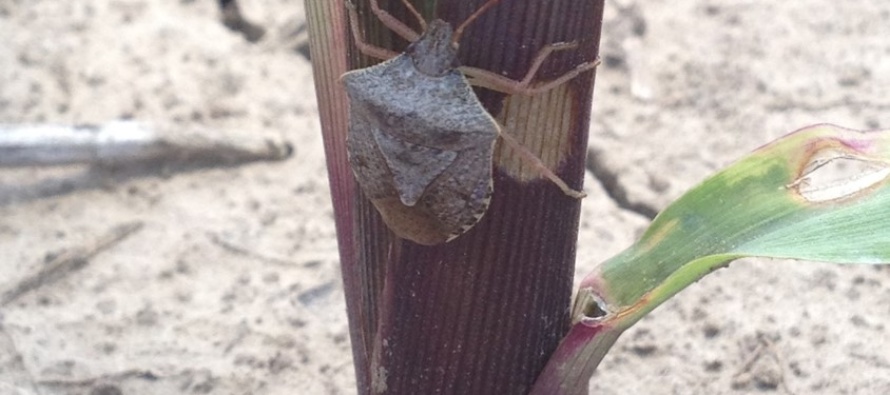Brown Stink Bugs in Seedling Corn

Related Articles
- 2010 Soybean And Corn Variety Trial Data 3
- Mississippi Cotton Insect Situation of 2010: A Look Back 3
- Rice Insecticidal Seed Treatment Recommendations for Mississippi in 2011 0
Latest Tweets
Over the last couple days we have begin to receive a few calls about brown stink bugs in seedling corn in the Delta region of the state. Stink bugs attack corn by feeding through the side of the stem or even down in the whorl of small corn plants. Typically the area where they feed becomes chlorotic due to enzymes in their saliva. Because the leaves they are feeding on are rolled up, when their mouthparts pierce through the leaves it makes several holes in the tissue neatly aligned in a row that stretch out with “wavy” margins as the leave emerges from the whorl. If stink bugs do not pierce the growing point, often the damage is cosmetic and the plants rapidly outgrow the symptomology. However, if the growing point is pierced, the plants may remain green but begin to sucker out and essentially become a weed and deplete surrounding plants of nutrients. It is also very important to remember that there are numerous other factors that closely resemble stink bug damage such as corn that was buggy whipped and “broke out” of the leaf curling due to fast growth causing and injured appearance to the leaves closely resembling stink bug damage. Chemical, hail, or mechanical damage can also appear similar to stink bug injury after the plants begin to grow rapidly.
Stink bug numbers generally appear to be much higher in fields that have residue in them although they can easily be found in some conventional tilled fields as well. Often numbers will be higher on field borders. They also appear to be heavily correlated to ryegrass clumps in the Delta. Many consultants have reported in the past seeing high numbers of brown stink bugs in clumps of roundup resistant Italian ryegrass.
Scouting stink bugs in seedling corn can be extremely frustrating because no matter how much you scout you will still see damaged plants. Often times the you will not find enough stink bugs to justify the amount of damage you are seeing. We discovered a few years ago that numerous brown stink bugs actually moved down beneath the residue during the heat of the day. By raking the residue back, we can find them hiding at soil level. I would not spend a lot of time raking residue unless your damage levels are unusually high. In conventional tilled fields with no residue and obvious stink bug damaged plants with very few bugs present, we believe that there is movement in and out of the field.When scouting brown stink bugs in corn be sure and look down in the whorls, on the sides of stems, and in developing brace roots. The threshold for stink bugs in seedling corn is 10% infested plants until plants reach 24″ in height. Keep in mind, with stink bugs in small corn, often the damage to the plant is not as bad as it may initially seem.
Because 99% of what is being found is brown stink bugs, products containing bifenthrin are the best choice. Pyrethroids are not my first choice for brown stink bugs in other crops, but it is really the best option in corn. Also, we often see better results in corn than soybeans because coverage is much better in small corn. I would recommend staying on the high end of rate range (1:20-1:25). If you observe rice stink bugs in corn, do not count them in counts.









Let me tell You a sad story ! There are no comments yet, but You can be first one to comment this article.
Write a comment